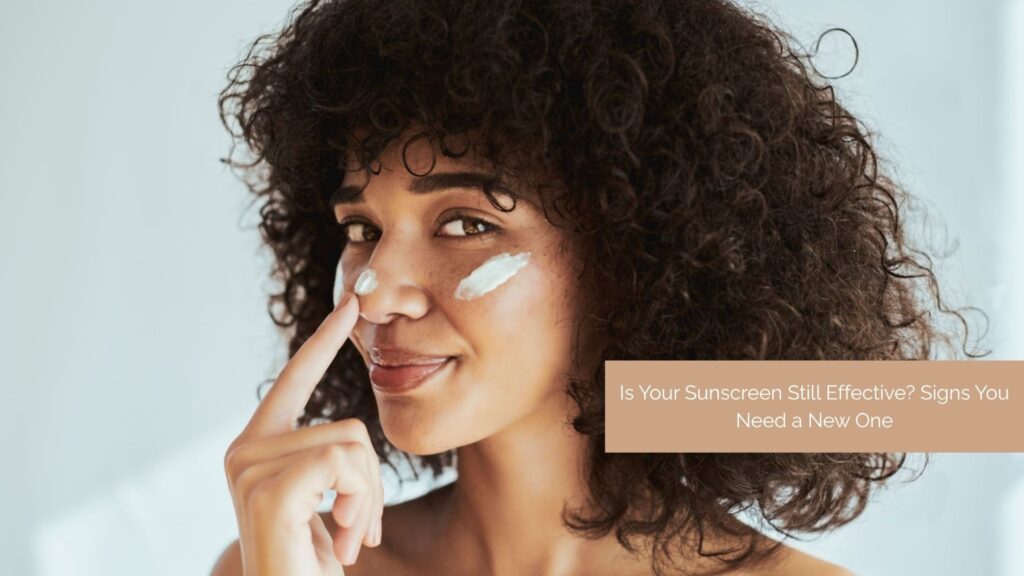🗓 By Jarvis – August 2025
⏱ Estimated reading time: 8 min

Sunscreen is one of the most important skincare products, especially during the hot summer months. But did you know that your sunscreen doesn’t last forever? Whether you’re using it from last summer or it’s been sitting in your beach bag for weeks, your sunscreen’s effectiveness can degrade over time. In this article, we’ll explore the signs that your sunscreen may no longer be doing its job and why you should consider replacing it for optimal protection.
The Importance of Fresh Sunscreen
Why Sunscreen Needs to Be Replaced Regularly
Sunscreen works by providing a protective barrier against harmful UV rays, but that protection diminishes over time. Most sunscreens have an expiration date, typically 2–3 years from the manufacturing date. After this period, the chemical and physical ingredients in the sunscreen can break down, leading to reduced effectiveness. It’s important to regularly check your sunscreen’s expiration date, especially if it’s been stored improperly.
What Happens When Sunscreen Becomes Ineffective
As sunscreen ages, the active ingredients like zinc oxide or chemical filters lose their potency. This makes your sunscreen much less effective at protecting your skin from sunburn and UV damage. Applying expired or degraded sunscreen may leave your skin vulnerable to burns, premature aging, and other sun-related skin issues. Always ensure your sunscreen is within its usable period for the best protection.
Texture and Consistency Changes
A Change in Texture Can Be a Warning Sign
One of the first indicators that your sunscreen may have gone bad is a change in texture. If your sunscreen starts to feel grainy, overly thick, or unusually oily, it’s a sign that the formula has oxidized. These changes usually occur when sunscreen has been exposed to heat or sunlight for too long, causing the ingredients to break down. A change in texture makes it less effective and can even cause skin irritation.
How to Check for Separation or Clumping
If you notice that your sunscreen has separated into layers or contains clumps, it’s time to discard it. While some sunscreens may naturally separate over time, a quick shake or stir should restore the consistency. If this doesn’t help, the product has likely gone bad. Avoid using it to ensure your skin isn’t exposed to potential harm.
Altered Smell and Color
Unusual Smells Indicate Degradation
Another sign that your sunscreen has lost its effectiveness is a change in smell. A sour, rancid, or chemical odor typically means that the product has degraded. Sunscreens, like many cosmetic products, contain oils and chemicals that can oxidize and emit a foul smell as they break down. If your sunscreen doesn’t smell fresh, it’s safer to throw it away and invest in a new bottle for maximum protection.
Discoloration or Darkening of the Product
Sunscreens can also change color when they begin to break down. If the lotion or spray appears darker, yellowed, or uneven in color, it’s likely no longer safe to use. These discolorations are an indication that the sunscreen has undergone chemical changes, which may reduce its ability to shield your skin from harmful UV rays.
Storage and Usage Tips
Proper Storage Extends Sunscreen’s Lifespan
The way you store your sunscreen plays a critical role in maintaining its effectiveness. Heat, humidity, and direct sunlight can all speed up the degradation process. For example, storing your sunscreen in your car or leaving it on a windowsill where it’s exposed to sunlight can significantly shorten its shelf life. To maximize its longevity, always store sunscreen in a cool, dry place, away from direct sunlight.
When You Don’t Remember When You Bought It
If you’re unsure when you purchased your sunscreen, it’s better to be safe than sorry. Sunscreen that’s over a year old and may have been improperly stored should likely be replaced. If it’s not visibly expired but has been exposed to heat or sunlight, it’s still wise to replace it, as its protective quality could be compromised. For complete peace of mind, always buy a fresh bottle of sunscreen every season.
Conclusion:
In the heat of summer, sunscreen is essential for protecting your skin from harmful UV rays. However, its effectiveness is not eternal. By paying attention to signs like changes in texture, smell, color, and expiration date, you can ensure that your sunscreen is still up to the task. Remember to store your sunscreen properly, replace it regularly, and stay vigilant about its condition. Your skin’s health is worth it!
FAQ Section:
1. How long is sunscreen effective after opening?
Sunscreen is generally effective for 2–3 years after opening, provided it’s stored correctly. Always check the expiration date to ensure full protection.
2. Can I still use sunscreen if it smells fine but the texture has changed?
If the texture of your sunscreen has changed, it’s best not to use it, even if the smell seems fine. The breakdown of ingredients can still reduce its effectiveness.
3. Does sunscreen expire even if it hasn’t been used?
Yes, sunscreen expires even if it’s never been used. Check the expiration date on the packaging for guidance.
4. Can I extend the shelf life of my sunscreen by refrigerating it?
While refrigeration can help preserve certain skincare products, it’s not necessary for sunscreen. Just store it in a cool, dry place, away from direct sunlight, to maintain its effectiveness.

